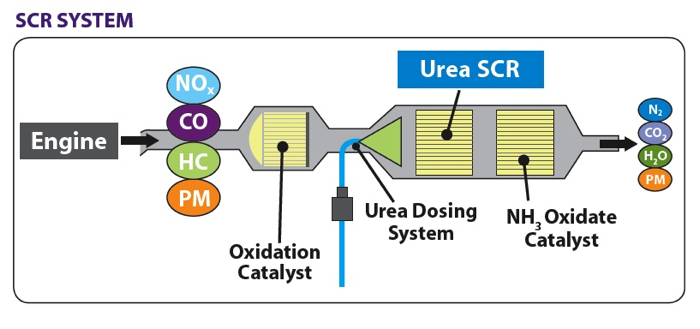The Diesel Technology Forum recently issued the following explanation on Selective Catalytic Reduction (SCR), an advanced active emissions control technology system used in clean diesel engines.
Selective Catalytic Reduction (SCR) is a proven and advanced active emissions control technology system that injects a liquid-reductant agent through a special catalyst into the exhaust stream of a diesel engine. The reductant source is usually automotive-grade urea, otherwise known as Diesel Exhaust Fluid (DEF). The DEF sets off a chemical reaction that converts nitrogen oxides into nitrogen, water and tiny amounts of carbon dioxide (CO2), natural components of the air we breathe, which is then expelled through the vehicle tailpipe.
SCR technology is designed to permit nitrogen oxide (NOx) reduction reactions to take place in an oxidizing atmosphere. It is called “selective” because it reduces levels of NOx using ammonia as a reductant within a catalyst system. The chemical reaction is known as “reduction” where the DEF is the reducing agent that reacts with NOx to convert the pollutants into nitrogen, water and tiny amounts of CO2. The DEF can be rapidly broken down to produce the oxidizing ammonia in the exhaust stream. SCR technology alone can achieve NOx reductions up to 90 percent.

Why is SCR important?
SCR technology is one of the most cost-effective and fuel-efficient technologies available to help reduce diesel engine emissions. Its effectiveness allows diesel engines to be tuned and optimized toward maximum fuel efficiency, while the SCR systems are highly efficient at treating the engine-out exhaust.
The largest sector for use of SCR technology in the US is heavy-duty commercial trucks. All heavy-duty diesel truck engines produced after January 1, 2010 must meet the latest EPA emissions standards, among the most stringent in the world, reducing particulate matter (PM) and nitrogen oxides (NOx) to near zero levels. SCR can reduce NOx emissions up to 90 percent while simultaneously reducing HC and CO emissions by 50-90 percent, and PM emissions by 30-50 percent.
In the commercial trucking industry, some SCR-equipped truck operators are reporting fuel economy gains of 3-5 percent. Additionally, off-road equipment, including construction and agricultural equipment, must meet EPA’s Tier 4 emissions standards requiring similar reductions in NOx, PM and other pollutants. SCR is also used in some of the many different applications of off-road engines and equipment.
Where is SCR used?
SCR has been used for decades to reduce stationary source emissions from various industrial operations. In addition, marine vessels worldwide have been equipped with SCR technology, including cargo vessels, ferries and tugboats. With its superior return in both economic and environmental benefits, SCR is also being recognized as the emissions control technology particularly helpful in meeting the U.S. EPA 2010 diesel engine emission standards for heavy-duty vehicles and the Tier 4 emissions standard for engines found in off-road equipment. SCR systems are also found in the growing number of diesel passenger vehicles.
What are the special considerations of using SCR?
One unique aspect of a vehicle or machine with an SCR system is the need for replenishing Diesel Exhaust Fluid (DEF) on a periodic basis. DEF is carried in an onboard tank which must be periodically replenished by the operator. DEF consumption rates are determined by vehicle operation. More aggressive driving at higher speeds or while hauling heavy loads will increase DEF consumption. For most light-duty vehicles, DEF refill intervals typically occur around the time of a recommended oil change or other scheduled vehicle maintenance. DEF replenishment for heavy-duty vehicles and off-road machines and equipment will vary depending on the operating conditions, hours used, miles traveled, load factors and other considerations.
DEF is an integral part of the emissions control system and must be present in the tank at all times to assure continued operation of the vehicle or equipment. Low DEF supply triggers a series of escalating visual and audible indicators to the driver or operator. Once the tank reaches a certain level near empty, the vehicle starting system may be locked out the next time the vehicle is used, preventing the vehicle from being started without adequate DEF.
On-board tanks to store DEF are typically located in the spare tire area of passenger vehicles, while tractor trailers typically have a DEF tank alongside the diesel fuel saddle tank. Proper storage of DEF is required to prevent the liquid from freezing at temperatures below 12 degrees Fahrenheit, and most vehicle DEF dispensing systems have warming devices.
What is DEF?
Diesel Exhaust Fluid (DEF) is a non-toxic fluid composed of purified water and automotive grade aqueous urea. DEF is available with a variety of storage and dispensing methods. Storage options consist of various size containers such as bulk, totes and bottles or jugs. The American Petroleum Institute rigorously tests DEF to ensure that it meets industry-wide quality standards.
A nationwide DEF distribution infrastructure has rapidly expanded to meet the needs of a growing SCR technology marketplace. Since 2010, DEF has been widely available for purchasing at various locations like service stations, convenience stores, automotive parts stores, Wal-Mart, and petroleum retailers as well as truck stops, truck dealerships and engine distributors. DEF tanks on vehicles typically range in size from 6 to 23 gallons depending on the type of vehicle application. The DEF tank fill opening is designed to accommodate a DEF fill nozzle to ensure only DEF is put into the tank. A diesel fuel nozzle will not fit into the DEF tank opening.
Most heavy-duty truck manufacturers calculated operating costs of new SCR-equipped vehicles based on a DEF price of $3 per gallon, however, the price of DEF responds to market conditions of supply and demand and is expected to decrease due to the growing network of DEF supply.














